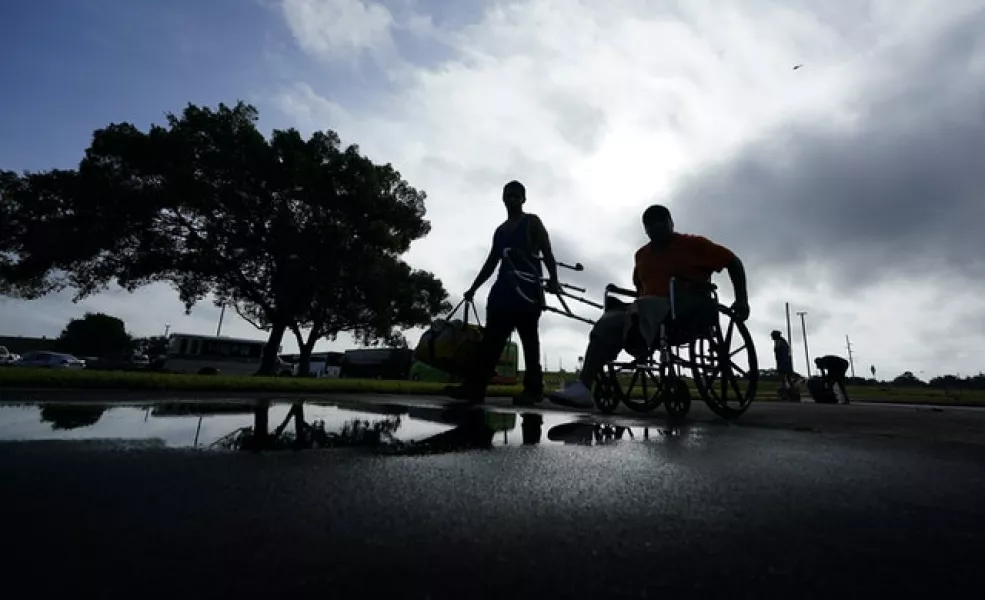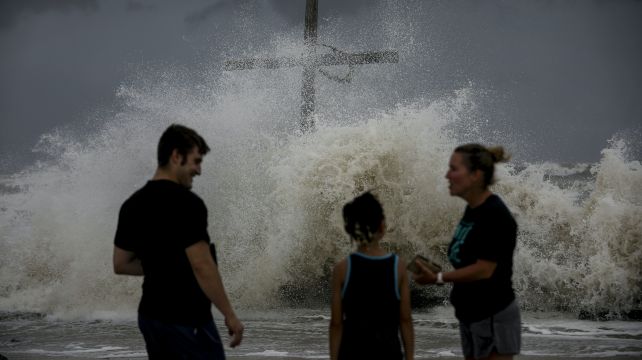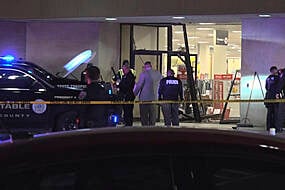The National Hurricane Centre said the storm, which intensified rapidly on Wednesday before ploughing into land, came ashore near Cameron, a 400-person community about 30 miles east of the Texas border.
“Potentially catastrophic impacts will continue,” forecasters said.
Winds gusted above hurricane force to 128 mph while Laura’s northern eyewall moved onshore over Cameron Parish.
Forecasters said even stronger winds were possible that could rip apart buildings, level trees and toss vehicles like toys.
Authorities had implored coastal residents of Texas and Louisiana to evacuate, but not everyone did before howling winds began buffeting trees back and forth in an area that was devastated by Rita in 2005.
“There are some people still in town and people are calling the building but there ain’t no way to get to them,” Tony Guillory, president of the Calcasieu Parish Police Jury, said over the phone as he hunkered down in a Lake Charles government building that was shaking from the storm.
At 1 am CDT, Hurricane #Laura has made landfall in southwestern Louisiana near Cameron as a category 4 #hurricane. Maximum sustained winds were 150 mph, with a minimum central pressure of 938 mb. Potentially catastrophic impacts will continue. More: https://t.co/tW4KeFW0gB pic.twitter.com/GVWRnmGejy
— National Hurricane Center (@NHC_Atlantic) August 27, 2020
Mr Guillory said he hopes those stranded can be rescued later on Thursday but he fears that blocked roads, downed power lines and flooding could delay that process.
Video and photos on social media showed torrents of rain flying sideways past street lights in Lake Charles, and streets covered with water closer to the coast.
A sudden storm surge knocked over cameras meant to capture the hurricane’s effects.
With hours of violent weather ahead, officials said the extent of destruction likely would not be clear until daybreak, when search and rescue missions will begin.
Drawing energy from the warm Gulf of Mexico, the system arrived early on Thursday during high tide as the most powerful hurricane to strike the US so far this year.
“It looks like it’s in full beast mode, which is not what you want to see if you’re in its way,” University of Miami hurricane researcher Brian McNoldy said.

Earlier on Wednesday, winds picked up as shoppers rushed into a grocery store in low-lying Delcambre.
Trent Savoie, 31, said he was staying put. “With four kids and 100 farm animals, it’s just hard to move out,” he said.
Texas governor Greg Abbott and Louisiana governor John Bel Edwards fretted that the dire predictions were not resonating despite authorities putting more than 500,000 coastal residents under mandatory evacuation orders.
Officials said at least 150 people refused pleas to leave and planned to weather the storm in everything from elevated homes to recreational vehicles in coastal Cameron Parish, which could be completely covered by ocean water.
“It’s a very sad situation,” said Ashley Buller, assistant director of emergency preparedness. “We did everything we could to encourage them to leave.”
Mr Edwards activated the state’s entire National Guard.
The power of #HurricaneLaura is deadly, & Texans must take action now to get out of harm's way & protect themselves & their loved ones.
The conditions of this storm are unsurvivable, Texans in the path of the storm are urged to evacuate immediately.https://t.co/P9NxLLj5tW— Gov. Greg Abbott (@GovAbbott) August 26, 2020
In Lake Charles, Guard members drove school buses around neighbourhoods, offering to pick up families.
Across the state line in Port Arthur, Texas, few stragglers boarded evacuation buses, and city officials announced that two C-130 transport planes offered the last chance to leave.
A Category 4 hurricane can render wide areas uninhabitable for weeks or months and knock out power for just as long.
The threat of such devastation posed a new disaster-relief challenge for a government already straining under the coronavirus pandemic.
The parts of Louisiana that were under evacuation orders included areas turning up high rates of positive Covid-19 tests.
The National Hurricane Centre kept raising its estimate of Laura’s storm surge, from 10ft just days ago to twice that size — a height that forecasters said would be especially deadly.
On Twitter, President Donald Trump urged coastal residents to heed officials.
Hurricane warnings were issued from San Luis Pass, Texas, to Intracoastal City, Louisiana, and reached inland for 200 miles. Storm surge warnings extended from Freeport, Texas, to the mouth of the Mississippi River.
Laura closed in on the US after killing nearly two dozen people on the island of Hispaniola, including 20 in Haiti and three in the Dominican Republic, where it knocked out power and caused intense flooding.
Laura will be the seventh named storm to strike the US this year, setting a new record for US landfalls by the end of August. The old record was six in 1886 and 1916, according to Colorado State University hurricane researcher Phil Klotzbach.







